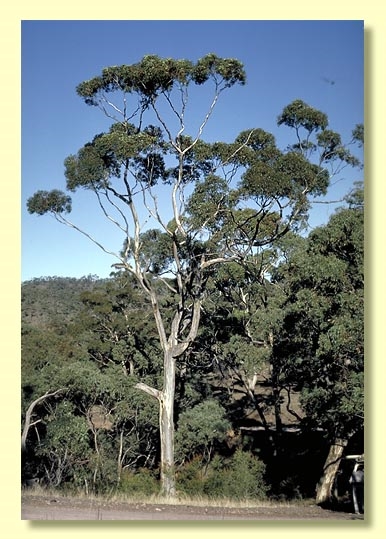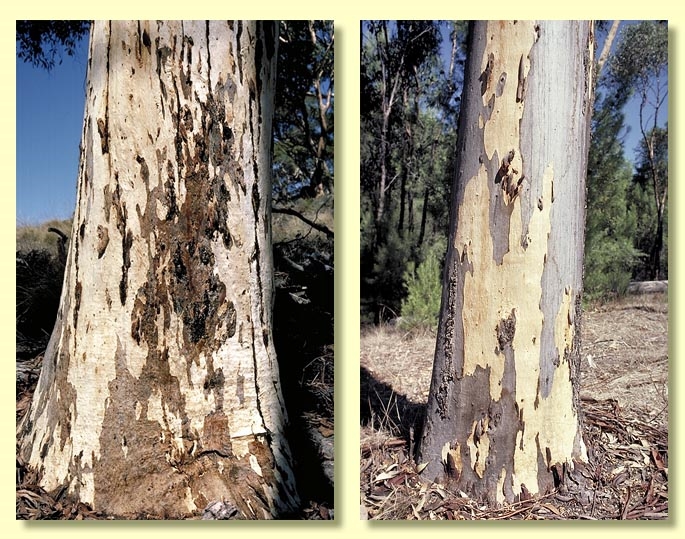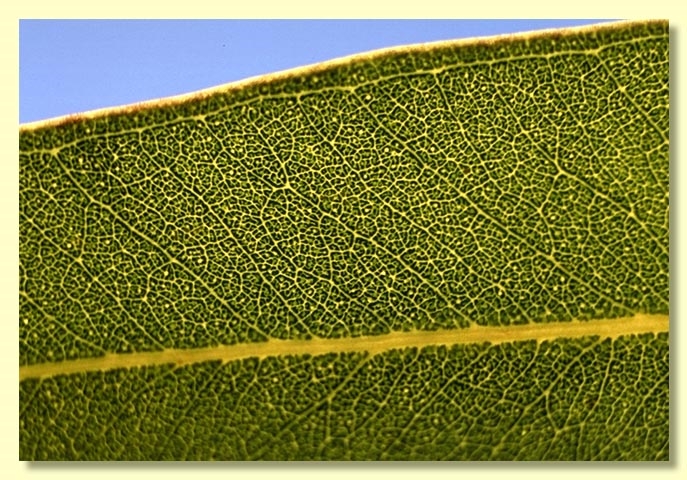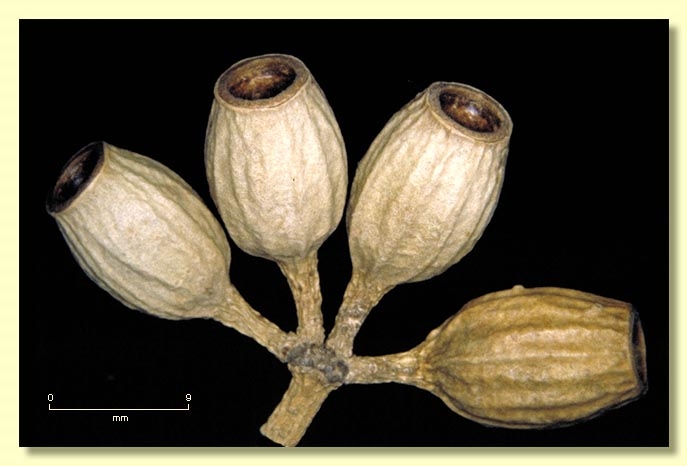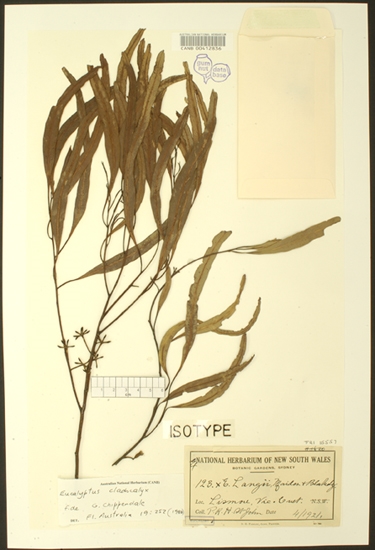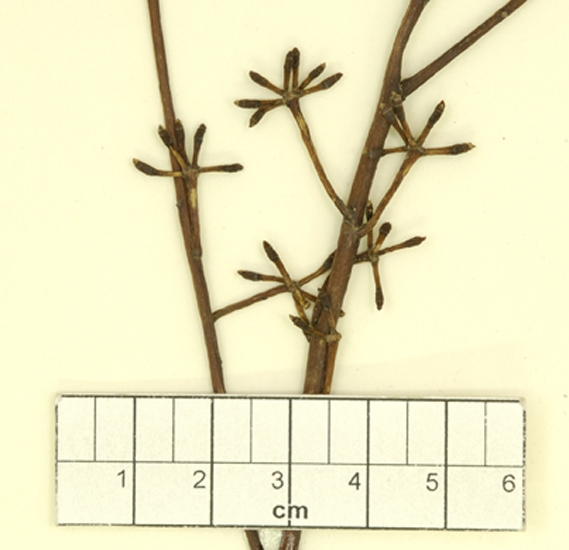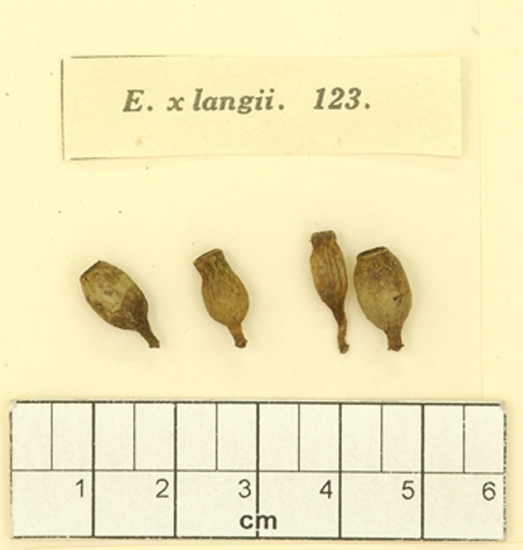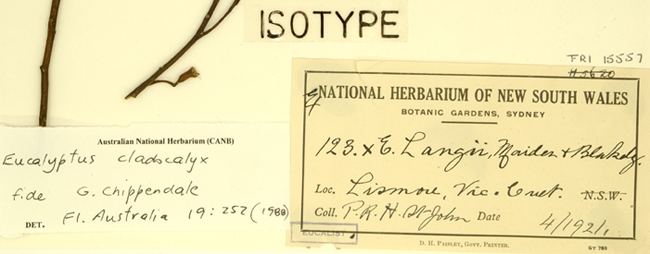Euclid - Online edition
Eucalyptus cladocalyx
Eucalyptus | Symphyomyrtus | Sejunctae
E. corynocalyx F.Muell., Fragm. 2: 43 (1860), nom. illeg. based on same types as E. cladocalyx.
T: Marble Ra., S.A., Feb. 1852, C.Wilhelmi s.n.; holo: MEL; iso: K.
E. langii Maiden & Blakely, Crit. Revis. Eucalyptus 8: 72 (1929). T: cultivated at Litanga Stn, Lismore, Vic., Apr. 1921, P.R.H.St John s.n.; holo: NSW, iso: CANB. (see image of type specimen held at CANB)
Bark smooth, mottled white, yellow, pink, orange, brown, pale grey, dark grey or blue grey, sometimes slightly powdery.
Juvenile growth (coppice or wild seedling to 50 cm tall): stems round in cross-section; juvenile leaves always petiolate, opposite at lowest node then alternate, orbicular (often wider than long), deltoid to ovate, 2–6.5 cm long, 2–9 cm wide, apex round or emarginate, base truncate, discolorous, dull, blue-green to green.
Adult leaves alternate, petiole 0.9–2.7 cm long; blade slightly falcate to lanceolate, 6.5–17 cm long, 1.2–4 cm wide, base usually tapering to petiole, strongly discolorous, glossy, darker green on upper side, paler below, side-veins at an acute or wider angle, densely to very densely reticulate, intramarginal vein parallel to and well removed from margin, oil glands small, obscure.
Inflorescence axillary unbranched but borne on leafless sections of branchlets (ramiflorous), peduncles 0.8–2.2 cm long, buds 7, 9 or 11 per umbel, pedicels 0.2–0.7 cm long. Mature buds oblong (0.8–1.1 cm long, 0.4–0.5 cm wide), pale green, yellow to creamy, often longitudinally striate, scar present, operculum rounded, stamens inflexed, anthers cuboid to oblong, versatile, dorsifixed, dehiscing by longitudinal slits (non-confluent), style short, stigma blunt, locules 3 or 4, the placentae each with 4 vertical ovule rows in each locule. Flowers white.
Fruit pedicellate (pedicels 0.2–0.7 cm long), urceolate or barrel-shaped, 0.6–1.6 cm long, 0.4–1.1 cm wide, often longitudinally ribbed, disc descending, valves 3 or 4, deeply enclosed.
Seeds light grey to brown, 1.5–3 mm long, ovoid or flattened-ovoid, or pointed at one end, dorsal surface smooth, with or without a very narrowly flanged rim, hilum ventral.
Cultivated seedlings (measured at ca node 10): cotyledons bilobed; stems square to rounded in cross-section; leaves always petiolate, opposite for 2 or 3 nodes then alternate, deltoid to ovate or orbicular (though often wider than long), 2.5–5.5 cm long, 2–6 cm wide, apex rounded to emaginate, dull, green at lowest nodes becoming grey to grey-green up stem.
Flowering has been recorded in January, March and December.
A small to tall tree of disjunct distribution endemic in South Australia from lower and central-eastern Eyre Peninsula, Kangaroo Island and the southern Flinders Ranges. It is not closely related to any other eucalypt species and may be distinguished by the mottled bark somewhat like that of grey gums, the orbicular petiolate juvenile leaves, strongly discolorous adult leaves that are paler on the underside, and inflorescences on leafless portions of branchlets inside the crown. It is probably a relic of tall forests of wetter climates in the distant past, although its morphological characters do not associate it with current wet forest species such as E. diversicolor and E. saligna.
Eucalyptus cladocalyx belongs in Eucalyptus subgenus Symphyomyrtus because buds have two opercula and ovules are in four rows. Within this subgenus E. cladocalyx is somewhat isolated as the only species in section Sejunctae by the combination of its unusual inflorescence arrangement, discolorous leaves, absence of pith glands, bilobed cotyledons and flattened-ovoid seeds.
Dean Nicolle in his excellent book Native eucalypts of South Australia (2013) pages 30-35, formally describes two new subspecies of E. cladocalyx, viz. subsp. crassa and subsp. petila. These are not included in the interactive key part of EUCLID because the most distinctive differences are to do with appearance – stature and branching, and also geography, with other features such as adult leaf dimensions, peduncle lengths and fruit length and width, overlapping considerably. The differences are outlined below:
Eucalyptus cladocalyx F.Muell subsp. cladocalyx is a tree to 18 m tall though often much shorter, with widely spreading crown, often branching low and with the branches not particularly upright, rarely a stunted shrub as low as 2 m tall in exposed heath; peduncles 1.1–2.2 cm long, fruit 0.8–1.5 cm long, 0.6–1 cm wide. Restricted to the hills of the southern and central-eastern Eyre Peninsula.
Eucalyptus cladocalyx subsp. crassa D.Nicolle is a tree to 45 m tall with a widely spreading crown, in woodlands and open forest usually on laterite soils; peduncles 1.4–2 cm long, fruit 0.9–1.6 cm long, 0.6–1.1 cm wide. Found only on Kangaroo Island.
Eucalyptus cladocalyx subsp. petila D.Nicolle is a tree to 40 m tall with more erect branching habit and noticeably smaller fruit, growing in woodland and open forest on ridges and steep slopes; peduncles 0.8–1.4 cm long, fruit 0.6–1 cm long, 0.4–0.7 cm wide. Occurs in the southern Flindrrs Ranges extending from Dutchman's Stern just north of Quorn south to Wirrabarra and Telowie.
Eucalyptus cladocalyx is widely planted on farms and in towns in southern Australia for shelter belts and shade in zones where rainfall is suitable. It is often lopped at ca 1 metre above ground level and the wood used for posts and fuel.
In Western Australia Eucalyptus cladocalyx has escaped from plantings and become naturalised (Hussey et al., 1997), for example at Pelican Point on the Swan River estuary, Perth, and is invading bushland near Esperance. In Victoria it has been recorded as naturalised near Connewarre on the Bellarine Peninsula. Carr et al. (1992) regard this species as an environmental weed in Victoria posing a serious risk to lowland grassland and grassy woodland, dry sclerophyll forest and woodland, riparian vegetation and vegetation on rock outcrops, stating that it is already widespread in small populations.


